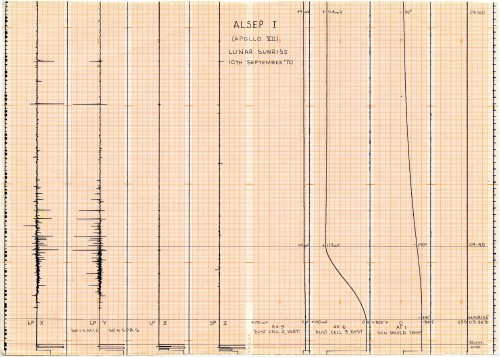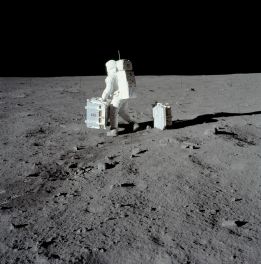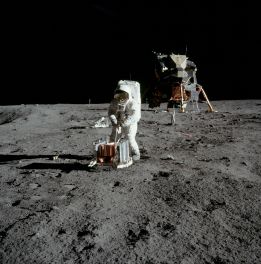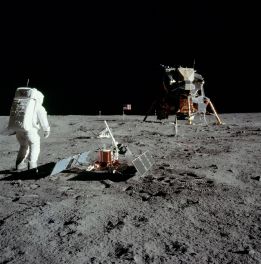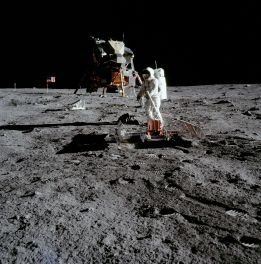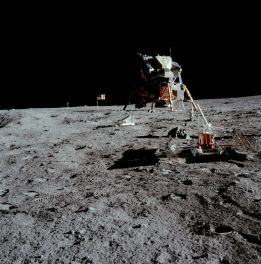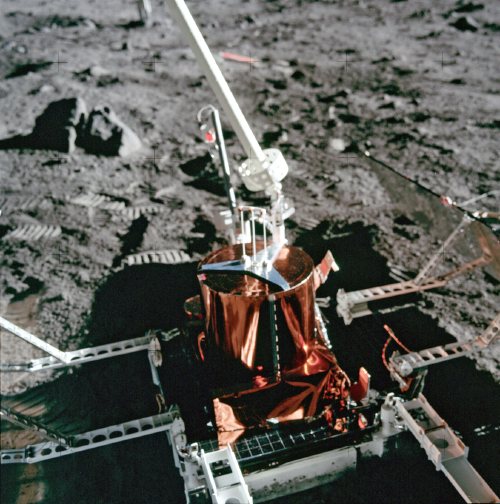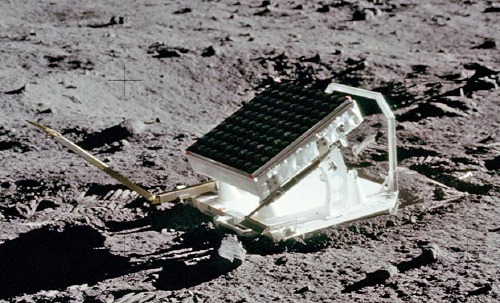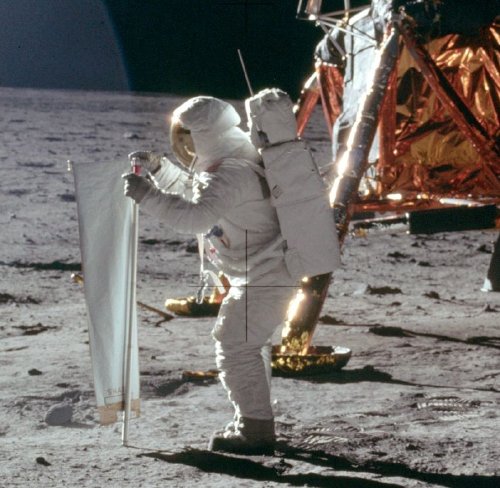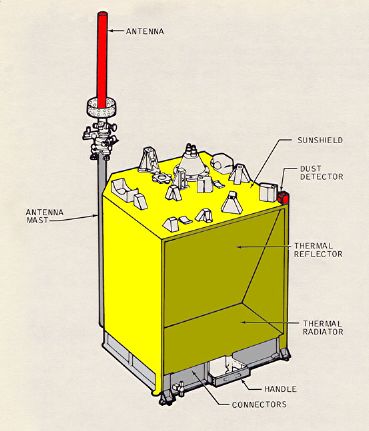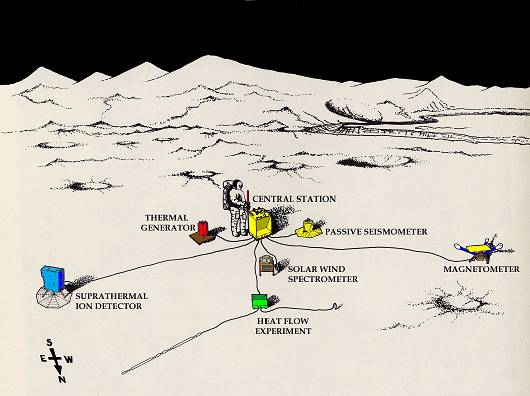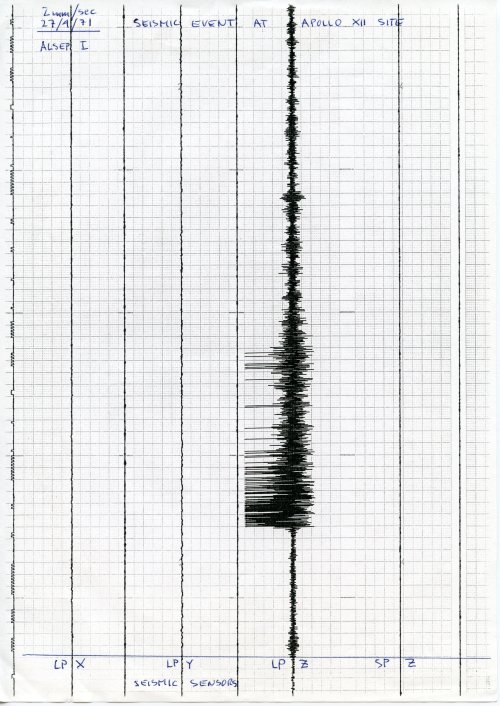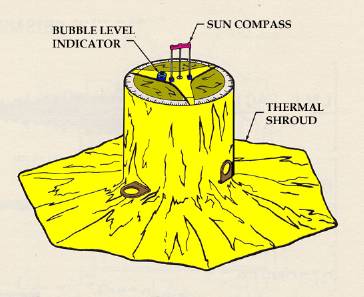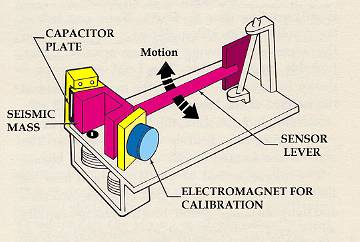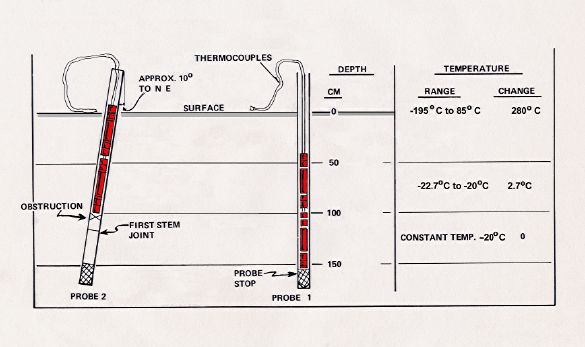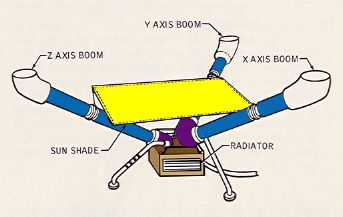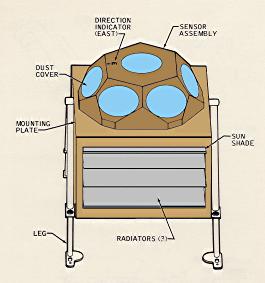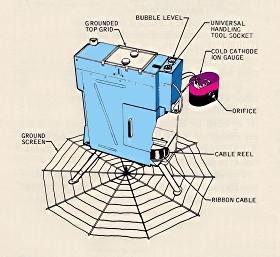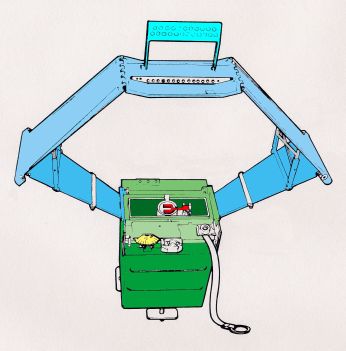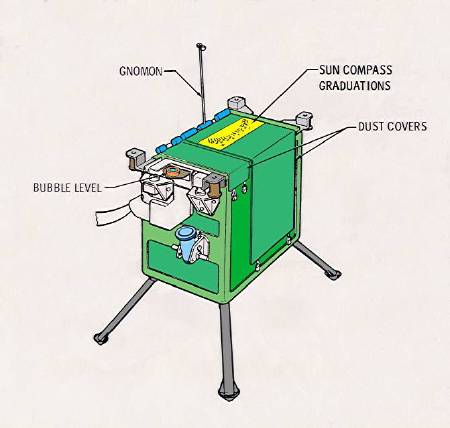IN THE BEGINNING.
The ALSEP program began on 31 March 1963 with a series of meetings
between NASA Headquarters, the Jet Propulsion Laboratory (JPL), and the Goddard
Space Flight Center (GSFC). The first choice of experiments was proposed in
December 1963, and consideration was given to those experiments that promised
maximum return for least weight and complexity. Suggested experiments were
active and passive seismic devices, instruments to measure the surface bearing
strength, magnetic field, radiation spectrum, soil density, and gravitational
field.
During the summer of 1965, the National Academy of Sciences Space Science
Board met at Woods Hole, Massachusetts, to consider the most desirable areas
of space study. The board proposed 15 major items for lunar exploration. Some
of them were:
What is the internal structure of the Moon?
What is the actual geometric shape of the Moon?
What is the present internal energy regime of the Moon?
What is the composition of the lunar surface?
What principal processes were responsible for the present structure of
the Moon?
What is the present tectonic pattern and distribution of tectonic activity
on the Moon?
What are the dominant processes of erosion, transport, and deposition
of material on the lunar surface?
What volatile substances are present on or near the lunar surface?
Are there organic and/or proto-organic molecules on the Moon?
What is the age of the Moon?
What is the history of dynamic interaction between the Earth and the Moon? |
From the list of questions from the Woods Hole meeting, it
was decided it was possible to design a complete lunar geophysical station,
which would give this information. It could be housed in a storage bay of
the LM and be deployed on the surface of the Moon by the astronauts.
By 7 June 1965 Dr George Mueller, the Associate Administrator for Manned Space
Flight, authorised a budget for ALSEP, and responsibility of the management
was assigned to the Manned Spacecraft Center’s Experiments Program Office.
With a budget now available, the MSC Office had prototypes
built by three firms: Bendix Systems Division, TRW Systems Group, and Space-General
Corporation, each given a $500,000, six month contract. The MSC Office would
select one of the three to develop the final ALSEP flight hardware.
On 14 February 1966 Homer E. Newall, advised the MSC Office
that he had assigned the experiments to specific missions, and the institutions
and principal investigators would be:
|
Passive Lunar Seismic Experiment, Massachusetts
Institute of Technology, Frank Press; Columbia University, George Sutton.
Lunar Tri-axis Magnetometer, Ames Research
Center, C. P. Sonett; MSC, Jerry Modisette.
Medium-Energy Solar Wind, Jet Propulsion
Laboratory (JPL), C. W. Snyder; JPL, M. M. Neugebauer.
Suprathermal Ion Detection, Rice University,
J. W. Freeman, Jr.; MSC, F. C. Michel.
Lunar Heat Flow Management, Columbia University,
M. Langseth; Yale University, S. Clark.
Low-Energy Solar Wind, Rice University, B.
J. O’Brien.
Active Lunar Seismic Experiment, Stanford
University, R. L. Kovach; U.S. Geological Survey, J. S. Watkins. |
On 16 March 1966 NASA Administrator James E. Webb and Deputy
Administrator Robert C. Seamans, selected Bendix Systems Division, Bendix
Corporation, to design, manufacture, test, and provide operational support
of the ALSEP packages, with the first delivery scheduled for July 1967. The
contract was approved by NASA on 5 November 1966.
The estimated cost of the
cost-plus-incentive-fee contract negotiated with Bendix before the presentation
by the Source Evaluation Board to Webb and Seamans, was $17.3 million.
Apollo 11.
EASEP
Due to Apollo 11 being more of a test flight than a scientific
mission, a simplified package was chosen. The Early Apollo Surface Experiments
Package (EASEP) was approved to be supplied by Bendix, on 5 November 1966
for Apollo 11.
The EASEP station, located at 0.6735°N latitude 23.4730°E
longtitude, was turned on at 1440 AEST 21 July 1969 and failed on 27 August
1969, 31 days beyond its designed lifetime.
EASEP only had two experiments:
1. Passive Seismic Experiment
Package (PSEP).
This instrument contained four seismometers powered by two
panels of solar cells, which converted solar energy into electricity. It used
three long-period seismometers and one short-period vertical seismometer for
measuring meteorite impacts and moonquakes, recording about 100 to 200 hits
by meteorites during its lifetime. Data regarding the strength, duration,
and approximate direction of the seismic event were relayed to tracking stations
on Earth.
|
|
The Apollo 11 Passive Seismometer station shortly after its deployment by Buzz Aldrin.
|
Because it was only powered by solar cells, the experiment
only operated during the lunar days. During the 340 hour lunar night, when
temperatures can plummet to minus 170°C the instrument was kept to a minimum
of minus 54°C by a radioisotope heater, the first major use of nuclear
energy in a NASA manned mission. Any temperature below this could damage the
instrument.
At the other end of the scale the scientists tried controlling
the daytime heat on the electronic components by a series of power ‘dumps,’
cutting off the system’s electrical power. Then, just before the lunar
night began, the seismometer automatically shifted into stand-by mode, stopping
transmission of all data. The seismic instrument package stopped responding
to commands at 1400 AEST 25 August 1969.
|
The Apollo 11 EASEP Passive Seismometer Experiment Package.
Larger, PDF.
Modified from an illustration by
Bendix Aerospace Systems Division, 1969.
|
|
|
|
Dr. Garry Latham
(on left), with the Lamont Geological Observatory, studies seismometer
tracings in the Mission Control Center’s ALSEP control room.
The electronic data was transmitted
from the Passive Seismic Experiments Package
which the Apollo 11 astronauts had just deployed on the surface of the
moon.
NASA image S69-39587. |
|
This scan of a copy of the first lunar seismogram – complete with signatures of the Apollo 11 crew, Dr Garry Latham, and other members of his team – is courtesy of Trevor Dalziell at Geoscience Australia.
It seems that this copy (now water damaged) was a part of the US display at Expo 88 in Brisbane. Apollo 15 astronaut Jim Irwin’s signature was added at the Expo. Somehow it made its way to the Geoscience Australia field station in Charters Towers, until it was transferred to Canberra in late 2011. Thanks also to Bruce Stewart for first mentioning this plot.
Click the image to see the full plot with annotations.
Large, Larger (2MB). |
2. Lunar Dust Detector (LDD).
This experiment measured the amount of dust accumulating on
the lunar surface.
It also measured the damage to solar cells by high-energy radiation
as well as the reflected infrared energy and temperatures of the lunar surface.
It consisted of three photocells mounted on the EASEP.
There were also two experiments which were not associated with
the EASEP:
Lunar Ranging Retro-Reflector (LRRR)
This passive experiment consisted of an array of 100 fused
silica cubes, arranged to reflect a beam of light back on a parallel path
to its origin. The LRRR placed on the Moon was aligned precisely so that it
faced the Earth. Scientists from around the world directed laser beams at
the instrument which reflected them back to Earth; the elapsed time for the
round trip allowed precise measurements of distances, down to an accuracy
of 8 centimetres, between the Earth and the Moon.
|
|
The Apollo 11 Lunar Ranging Retro-Reflector,
shortly after being deployed.
|
The very first lunar laser ranging observations of the Apollo
11 retro-reflector package were made with the 3.1-metre telescope at Lick
Observatory. However, the ranging system at Lick was designed solely for quick
acquisition and confirmation, rather than for an extended program. After a
further two LRRRs were deployed in the Apollo 14 and 15 missions, and as other
institutions around the world picked up the experiment, the data began to
extend our knowledge about the solar system, particularly the Earth/Moon relationship.
Before the Apollo 11 LRRR, only rough measurements could be
made. Although the moon is on average about 383,000 kilometres away from Earth,
using the LRRRs scientists are able to measure the Earth-moon distance to
an accuracy of about 8 centimetres. The reflector array allowed scientists
to precisely measure the moon’s orbit, spin rate and recession. Measurements
from the LRRRs show that the Moon is receding from Earth at a rate of about
3.8 centimetres per year. The measurements also allowed scientists to measure
all kinds of parameters about the moon, from the thickness of its crust to
the makeup of its iron core, to the motion of its axial wobble and warping
of the lunar surface. Results also proved that the ocean tides on Earth have
a direct influence on the Moon’s orbit.
Carroll Alley, a University of Maryland physicist who was principal
investigator for the reflector experiment said there seems to be no measurable
degradation in their performance, though there were predictions that lunar
dust, particularly from the LM ascent, would degrade the reflectors. These
reflectors are the only experiments left behind by the Apollo astronauts that
remain operational into the 21st century.
The Solar Wind Composition Experiment (SWC).
|
|
|
Buzz Aldrin deploys the Apollo 11
Solar
Wind Composition Experiment. |
|
|
The Solar Wind Composition Experiment on the
Lunar surface during the Apollo 11 EVA.
Neil Armstrong is moving out of frame at left.
AS11-40-5916. JSC scan
|
The Solar Wind Composition Experiment (SWC), an aluminium foil
panel, similar to household foil, that collected atomic particles released
by the Sun into space, was provided by scientists from Switzerland. It was
deployed and exposed for 1 hour 17 minutes and returned to Earth by the Apollo
11 crew for analysis. After the mission, scientists in Switzerland analysed
the exposed foil.
ALSEP
THE ALSEP SYSTEM AND EXPERIMENTS.
The ALSEP system, first flown on the Apollo 12 mission, consisted
of a Central Station with a nuclear power pack and a communications centre
with leads running out to the instruments placed around it. DC power of 70
watts at 16 volts was supplied by SNAP-27 model radioisotope thermo-electric
generators (RTG), placed beside the station and connected by cables. The generator
was filled with a radio-active plutonium fuel after the astronauts placed
it on the lunar surface. The nuclear fuel was carried to the Moon in a cask
mounted on the side of the LM, removed, and inserted in the generator by the
astronauts. The power required by the whole station and experiments was less
than the power of a 75 watt light bulb.
|
|
The ALSEP Central Station.
|
|
|
ALSEP configuration for Apollo
15.
|
The station and instruments had to be carried to a distance
of at least 90 metres from the LM, and was planned to take a maximum of 120
minutes to deploy, power up and initiate the experiments. The instruments
were arrayed around the central station, which supplied power to run the instruments
and provided two-way communications so data collected by the experiments could
be relayed to Earth and commands could be received. The central station was
a 25 kilogram box with thermal control achieved by passive elements (insulation,
reflectors, thermal coatings) as well as power dissipation resistors and heaters.
Communications with Earth was with transmitters, receivers, data processors
and multiplexers housed within the central station, with signals transmitted
through a 58 centimetre by 3.8 centimetre modified axial-helical antenna mounted
on top, and pointed towards Earth by the astronauts. Data collected from the
instruments was converted into a telemetry format and transmitted to Earth.
The ALSEP systems and instruments were controlled by commands
from Earth, sent through the tracking stations.
The uplink frequency for all Apollo ALSEPs was 2119.0 MHz.
The downlink frequencies were:
| ALSEP 1 |
Apollo 12 |
2278.5 MHz |
| ALSEP 3 |
Apollo 14 |
2279.5 MHz |
| ALSEP 2 |
Apollo 15 |
2278.0 MHz |
| ALSEP 4 |
Apollo 16 |
2276.0 MHz |
| ALSEP 5 |
Apollo 17 |
2275.5 MHz |
|
An unexpected problem with the first ALSEP on Apollo 12 involved the cables,
which connected the various units to the Central Station. Although the cables
were fairly stiff, on Earth they tended to lie flat to the ground, held down
by their own weight. However, on the Moon, the cables hardly seemed to notice
the one sixth gravity and retained loops and bends they had acquired during
storage inside the LM – loops that stood up from the ground rather like
sections of a frozen garden hose. There were no disastrous tripping episodes
during Apollo 12 such as occurred on Apollo 16, but the need to dodge cable
loops slowed the astronauts’ work.
ALSEP experiments varied from mission to mission but each mission
contained selections of the following experiments:
Lunar Passive Seismic Experiment. (PSE) S-031
University of Texas.
Apollo 12, 14, 15, 16.
To determine sub-surface properties and measure extremely small vibrations
of the lunar surface caused by distant moonquakes and man-made explosions
and spacecraft impacts.
As the instrument vibrates from crustal movement, the inertia
of the central lever and the mass on the end caused it to vibrate in sympathy,
which was detected electronically by the capacitor effect of the mass on the
end of the lever. An internal set of motors kept the seismometers constantly
level within a few seconds of arc. Seismic motions were recorded on Earth
with a magnification factor of 10 million. The network of four ALSEPs that
had the instrument enabled the seismologists to locate moonquakes in three
dimensions, and to study the seismic velocities and propagation characteristics
of the lunar subsurface materials. The ALSEPs measured daily meteorite impacts
and an average of two moonquakes per month, up to depths of 800 kilometres.
Earthquakes on the Earth exceed one million per year. On the Moon, there may
be up to 300. And they are much smaller than the ones on Earth. It was noted
that there was increased activity when the Moon was farthest from, and nearest
to, the Earth. As I have already mentioned above, the heat from sunrise on
the Moon’s surface used to be recorded by ALSEP each lunar day.
|
Ed von Renouard preserved this plot of a seismic event on April 27 1971 – as sent from ALSEP 1, left by Apollo 12.
Scan by Colin Mackellar.
|
The Passive Seismic Experiment studied the propagation of seismic
waves through the Moon and provided our most detailed look at the Moon’s
internal structure. The Apollo 11 seismometer returned data for just three
weeks but provided a useful first look at lunar seismology. More advanced
seismometers were deployed at the Apollo 12, 14, 15, and 16 landing
sites and transmitted data to Earth until September 1977. Each of these seismometers
measured all three components of ground displacement (up-down, north-south,
and east-west).
|
|
The Passive Seismometer station.
|
|
|
|
Detail of the Passive Seismometer
lever to sense the surface
vibrations. |
If a seismic event is observed by three or more seismometers
separated by distance, the time and location of the event can be determined.
Because seismic waves from distant events travel deeper into the Moon than
waves from nearby events, by measuring events at various distances from the
seismometer, one can determine how seismic velocities vary with depth in the
Moon. In turn, this information can be used to study the Moon’s internal
structure. Most of the events observed by the seismometers were due either
to moonquakes or to meteoroid impacts. However, the third stages of several
Saturn V rockets and the ascent stages of several lunar modules were deliberately
crashed onto the Moon after they were discarded. These man-made crashes produced
seismic events of known times and locations and helped to calibrate the network
of seismometers.
The Passive Seismic Experiment produced several important scientific
results:
Knowledge of Lunar Interior Structure.
Like the Earth, the Moon has a crust, mantle, and core. The lunar crust is
rich in the mineral plagioclase and has an average crustal thickness of 60–70
kilometres, which is about 3 times the average crustal thickness on Earth.
The lunar mantle lies between the crust and the core and consists mostly of
the minerals olivine and pyroxene. The core is probably composed mostly of
iron and sulphur and extends from the centre of the Moon out to a radius of
no more than 450 kilometres, i.e., the core radius is less than 25% of the
Moon’s radius, which is quite small. In comparison, the Earth’s
core radius is 54% of the Earth’s radius. However, the size of the lunar
core is not well constrained by existing seismic observations. Better constraints
came from the laser ranging retro-reflector and magnetometer experiments.
Distribution of Lunar Seismic Sources.
More than 1,700 meteoroid impacts were recorded by the seismometer network,
with impactor masses estimated to be between 0.5 and 5000 kilograms. Most
moonquakes occur at depths of 800 to 1000 kilometres. These occur at monthly
intervals at about 100 distinct sites, indicating that these moonquakes are
caused by stresses from changes in lunar tides as the Moon orbits the Earth.
These moonquakes are quite small, mostly with Richter scale magnitudes less
than 2. The amount of energy released by earthquakes in a typical year is
about 10 million times larger than that released by moonquakes in a year.
Only a few near-surface moonquakes were detected.
Attenuation of Seismic Waves.
Meteoroid impacts cause heavy fracturing in the upper 20 kilometres of the
lunar crust. These fractures in turn cause scattering of seismic waves in
these regions. Below 20 kilometres, seismic wave scattering decreases as a
result of either closure of these fractures due to increasing pressure or
of a change in chemical composition of the crust. In the mantle, seismic waves
are attenuated much less on the Moon than they are on Earth. Seismic wave
attenuation is enhanced at high temperatures and in the presence of water,
and the low attenuation on the Moon indicates a cold, dry interior. Because
the Moon is smaller than Earth, it is expected to have cooled more rapidly,
producing a cold interior. The apparent absence of water may be due either
to the failure of the Moon to accumulate water when it formed or to subsequent
loss of water to space. Below 1000 kilometres depth, seismic wave attenuation
increases, possibly indicating the presence of a small amount of molten rock.
Scientists hoped that moonquakes and meteorite hits would answer
the questions; does the Moon have a molten core and what is the deep interior
of the Moon like? To answer these questions they needed at least one large
impact event of at least 1019 ergs on the back of the Moon. On 13 May 1972 a front side event
with an energy of 1,100 kilograms was recorded. On 19 September 1973 a large
back side event with an energy of 10^18 ergs took place. On 17
July 1972 only three months after it was set up, Apollo 16’s seismometer
registered the largest impact ever recorded on the moon when a meteorite hit
the far side of the moon near Mare Moscoviense, located at 26°N 147°
E.
Over the 8 years of the ALSEP’s lives, around 10,000 moonquakes
and 2,000 meteorite impacts were registered by the seismometers.
The seismic information, magnetometer, and heat flow experiments
contributed the principal information about the Moon’s interior. It is
now believed the Moon’s crust is multi-layered and from 60 to 100 kilometres
thick, with a secondary boundary occurring about 20 kilometres under the surface.
The upper mantle has been determined to consist of olivine or olivine-pyroxene
matter, and to be quite homogeneous, extending about 500 kilometres down.
Below this level the seismic data infers the interior is iron-enriched, although
there is insufficient data to determine if the Moon has a molten core.
Moonquakes were discovered to show periodicity and recur at
several places in the interior. The time cycle of the deep focus moonquakes
follows the tidal cycles so closely it appears likely that tidal forces are
a major factor in triggering deep focus moonquakes.
The Moon rings like a bell when struck by a large object.
The first man-made crash directed at the Moon that could be
detected by a seismometer occurred after the Apollo 12 astronauts had returned
to the CSM and the LM ascent stage was sent smashing into the Moon’s
surface. The shock waves of this impact surprised the scientists – the
Moon vibrated for over 55 minutes!! Also, the kinds of signals recorded by
the seismometers were utterly different from any ever received before, starting
with small waves, gaining in size to a peak, and then lasting for incredibly
long periods of time. A seismic wave took 7 to 8 minutes to reach the peak
of impact energy and then gradually decreased in amplitude over a period that
lasted almost an hour. It was claimed that even after an hour the minutest
reverberations had still not stopped.
When the Apollo 12 LM hit the lunar surface at 6,048 kilometres
per hour, 72 kilometres from the landing site, digging an estimated 9 metre
wide crater, the results were astonishing. All 3 seismometers in the package
recorded the impact, which set up a sequence of reverberations lasting nearly
an hour. Nothing like this had ever been measured on Earth. The LM impact
occurred at 1617 USCST 20 November (0817 AEST 21 November) 1969. A news conference
had been scheduled to begin at 1630, and when it did start, the Moon was still
“ringing” as the scientists – all of them seismic experts –
arrived at the news centre from their laboratories.
Maurice Ewing, co-head of the seismic experiment, told the
afternoon news crowd of the unexpected event, informing them that the Moon
was still ringing. He confessed he was at a loss to explain why the Moon behaved
so strangely. “As for the meaning of it,” Ewing announced, “I’d
rather not make an interpretation right now. But it is as though one had struck
a bell, say, in the belfry of a church a single blow and found that the reverberation
from it continued for 30 minutes.” As he spoke the reverberations continued
on for another 25 minutes.
|
|
The seismometer trace displaying
the Apollo 12 Lunar Module impact.
|
I asked our resident lunar scientist, Dr Ross Taylor, who had
been on the team to examine the Apollo 11 samples in Houston, to explain why
the Moon rang for so long, and he explained:
“This was one of those extraordinary things. When
you had the impact of these things on the Moon, unlike a terrestrial earthquake,
which dies away quickly, the shock waves continued to reverberate around the
Moon for a period of an hour or more, and this is attributed to the extremely
dry nature of the lunar rock. There is no moisture on the Moon, nothing to
damp out these vibrations. The Moon’s surface is covered with rubble
and this just transmits these waves without them being damped out in any way
as they are on Earth. Basically, it’s a consequence of the Moon being
extremely dry.”
Lunar Active Seismic Experiment (ASE). S-033
Stanford University.
Apollo 14, 16.
The Active Seismic Experiment was complementary to the Passive
Seismic Experiment in two ways, scale and source of energy. The Passive Experiment
was designed to study the whole Moon; the Active Experiment to study the local
area. Rather than wait passively for natural events to occur on the Moon to
produce shock waves, the Active Experiment provided its own sources. The shock
waves are produced by explosions on the lunar surface. Two different kinds
are used, small ones made while the astronauts are on the surface and large
ones after they left the site and returned to the Earth.
The different kinds of sources for the Active Experiment were
a “thumper” and a “mortar.” The thumper was used by the
astronaut to explode ’’shotgun-like’’ charges. The thumper
contained 19 such charges. It was fired at evenly spaced intervals along the
geophone line. The results from this part of the experiment were available
while the astronauts were still on the surface of the Moon.
The second kind of charge was similar to that of a mortar.
In fact, the unit that fired these charges was referred to as a mortar package
assembly. It contained four grenades that were launched using self-contained
rockets sometime after the astronauts had left the Moon. The astronauts aligned
the mortar launcher and armed it for firing. This unit contained geophones
for measuring the velocity of each grenade on launch and the exact time of
launch. Each grenade contained a rocket motor, a high explosive charge, provisions
for igniting the rocket and a device to detonate the charge, a battery, a
transmitter that provided information as to the length of time of the flight
and the moment of impact on the Moon, and a thread with which to measure the
distance of the impact from the launcher. Because there is no atmosphere on
the Moon, the thin thread trailing the grenade remained taut and measured
accurately the horizontal distance from the point of launch to the point of
impact. They had been designed to impact the Moon at distances of 137, 282,
853, 1372 metres from the launcher. The size of the explosive charge increased
with distance. Any layering in the Moon that is present in the first 300 metres
beneath the surface would be seen with the Active Experiment.
Two experiments, the Active Seismic Experiment on Apollo 14
and 16 and the Lunar Seismic Profiling Experiment on Apollo 17, were
performed to determine the detailed structure of the upper kilometre of the
lunar crust. Both experiments involved detonation of a series of small explosives.
The seismic waves, or ground vibrations, caused by these explosions were measured
by a network of geophones (a kind of electronic stethoscope). On Apollo 14
and 16, up to 19 explosions were detonated by an astronaut using a
device called a “thumper” along a 90-metre-long geophone line. On
Apollo 16, three mortar shells were also used to lob explosive charges
to distances of up to 1,300 meters from the ALSEP.
Both the Apollo 16 mortar shells and the Apollo 17 explosives
were detonated by radio control after the astronauts left the lunar surface.
These experiments showed that the lunar seismic velocity is
between 0.1 and 0.3 kilometres per second in the upper few hundred metres
of the crust at all three landing sites, which agrees closely with the passive
data. These velocities are much lower than observed for intact rock on Earth,
but are consistent with a highly fractured or brecciated material produced
by the prolonged meteoritic bombardment of the Moon. At the Apollo 14 site
there was a regolith surface layer of 8.5 metres. At the Apollo 17 landing
site, the surface basalt layer was determined to have a thickness of 1.4 kilometres,
slightly higher than the 1 kilometre thickness determined from the Traverse
Gravimeter Experiment.
Heat Flow Experiment. (HFE) S-037
Columbia University.
Apollo 15, 16, 17.
Heat flows from hot regions to cooler regions. The interior of the Moon is
warm compared to the surface, therefore heat flows from the interior to the
surface where it is lost into space by radiation. This heat is mainly produced
by the decay of natural radioactive elements thorium, uranium, and potassium,
raising the heat of the interior of the Moon. The Heat Flow experiment was
designed to measure the heat loss from the interior of the Moon. Two holes
were drilled into the lurain to a depth of 3 metres and platinum resistance
thermometers were placed at several points in the lower part of the holes
and several thermocouples were placed in the upper parts of the holes.
The importance of the Heat Flow Experiment was used to set
the limits on the amount of radioactivity of the Moon, and to set limits on
models of the thermal history of the Moon. The rate at which a planet loses
its internal heat to space is an important control on the level of tectonism
(faulting and folding of the planet’s surface due to internal deformation)
and volcanic activity on the planet. This loss of internal heat was measured
by the Heat Flow Experiments on Apollo 15 and 17. This experiment was
also attempted on Apollo 16, but failed due to a broken cable connection.
The HFE involved drilling two holes into the regolith to depths
of 1.6 to 2.3 metres. The temperature was measured at several depths within
the hole. The rate at which temperature increases with depth is a measure
of the heat flowing from the Moon’s interior. The drilling caused some
heating within the hole, although the effects of this heating decayed with
time. Also, temperatures in the upper part of the regolith vary as the amount
of incident sunlight changes throughout the lunar day and night. By monitoring
temperatures in the drill holes over a long period of time, these effects
can be accounted for, allowing a determination of the average heat flow rate
at the landing site.
|
|
The Apollo 15 Heat Flow core
and probe situation.
|
The HFE found that the surface layer temperature during the
night was 76K (-197°C) rising to a maximum of 358K (+85°C) during
the day. The temperature at 1.5 metres under the surface was a constant 253K
(-20°C), indicating the regolith is an excellent thermal insulator. The
results of these measurements indicate a heat flow of 21 milliwatts per square
metre at the Apollo 15 landing site and of 16 milliwatts per square metre
at the Apollo 17 landing site. The Earth’s average heat flux is 87 milliwatts
per square metre. The small value of the lunar heat flow was expected, given
the Moon’s small size and the observation that it has been nearly dead
volcanically for the last 3 billion years. Because the heat flow was measured
at only two locations, it is not known how representative these values are
for the Moon as a whole. However, because both measurements were obtained
near boundaries between mare and highland regions, it is thought that the
measured heat flows are probably 10–20% higher than the average value
for the entire Moon.
Lunar Surface Magnetometer (LSM). S-034
University of Arizona.
Apollo 12, 15, 16.
A tri-axis fluxgate magnetometer measured the variations of the magnetic field
of the Moon with time. Because the magnetic field of the Moon can change in
amplitude, frequency, and direction, the magnetometer measures the field in
three directions with sensors located on the end of three small booms. The
electronics were contained in a box at the base of the three booms. It could
measure magnetic flux in nanoTeslas in three ranges:
-100 to +100 nT
-200 to +200 nT
-400 to +400 nT
with a resolution of 0.2 nT.
|
|
|
The ALSEP Lunar Surface Magnetometer. |
Magnetic fields of the Earth and Moon have two parts; one that
changes with time, and one that is steady. The part that changes with time
is caused by travelling electromagnetic waves. The steady part of the Earth’s
magnetic field, which affects the common compass, varies from 35,000nT at
the equator to 60,000nT at the poles, whereas the lunar magnetic field is
only about 6 to 100 nT gamma, most likely due to the presence of natural magnetism
in lunar rocks inherited early in the Moon’s history, when the magnetic
field was much stronger that it is today.
The Lunar Orbiters’ data inferred there was a steady magnetic
field of about 8 nT. The magnetometer also measured the variation in time
of the magnetic field, caused by electromagnetic waves propagated from the
Sun.
The moon has no global magnetic field like the Earth because
it no longer has an internal dynamo, so it was a surprise when magnetometers
placed by Apollo astronauts on the surface detected a faint magnetic field,
as large as hundreds of nanoteslas. When the scientists built an electron
detector that flew aboard Apollo 15 in 1971 and Apollo 16 in 1972, they quickly
realised they could use the instrument to remotely map the magnetic fields
on the surface. Though crude and covering only about 10 percent of the lunar
surface, the measurements nevertheless indicated a correlation between meteor
impact basins – dark, roughly circular features on the face of the moon
and strong magnetic fields on the diametrically opposite side of the moon.
Theorists came up with an explanation for magnetic fields antipodal
to impact basins not long after the Apollo measurements hinted at a correlation.
When a large meteor hits the moon, it and much of the lunar surface is vaporized
and thrown into space, forming a cloud of debris and gas larger than the moon
itself. Because of the heat released in the collision, much of the gas is
ionised plasma in which the atoms are stripped of one or more electrons.
Such plasmas exclude magnetic fields, so as the cloud spread
around the moon it pushed the moon’s magnetic field in front of it. When
the plasma cloud finally converged on the diametrically opposite side of the
moon – a mere five minutes after impact – the squeezed magnetic
field would be quite large.
At the same time debris was falling back on the lunar surface,
concentrated at the antipodal site also. If this debris dropped onto the surface
during the time when the magnetic field was high, it could have undergone
shock magnetization. When rock is shocked, as when hit with a hammer, it can
suddenly lose its own magnetic field and acquire that of the surrounding region.
Scientists think that the magnetism of the Moon’s surface
is left over from a time when the Moon’s magnetic field was actively
created by a dynamo within the lunar core, and that this remnant magnetism
may gradually erode away. Theories also suggest that the Moon’s magnetism
may come from collisions with other celestial bodies such as asteroids and
comets, which might have imparted to the Moon some magnetic properties.
The LSM measured a steady 38 nT at the Apollo 12 site, and
6 nT at the Apollo 15 site.
Lunar Dust Detector. (LDD) M-515
Manned Spacecraft Center, Texas
Apollo 12, 14, 15.
This experiment measured the amount of dust accumulating on the lunar surface,
which translated into the solar illumination detected by the cells. It also
measured the damage to solar cells by high-energy radiation as well as the
reflected infrared energy and temperatures of the lunar surface. It consisted
of three photocells mounted on the Central Station.
Prior to the Apollo landings, it was thought that there would
be a heavy dust layer deposited on the ALSEP experiment package during LM
ascent and possibly from other long-term sources. This experiment was designed
to measure this dust layer deposition and was performed on Apollo 11, 12,
14, and 15 missions. It was housed in the ALSEP central station and
measured the power output and temperature of the three solar cells. The dust
accumulation proved to be much lower than expected, and the results from this
experiment were also used to monitor the long-term degradation of solar cells
from radiation and thermal effects. This was considered to be an engineering
rather than a scientific experiment.
The function of the experiment was to separate and measure
high-energy radiation damage to the solar cells, to measure reduced solar
cell output due to dust accumulation, and to measure reflected infrared energy
and temperatures for use in computing lunar surface temperatures. The Dust
Detector had two components – a sensor package mounted to the top of
the Central Station sun shield, and a printed circuit board located within
the Central Station that interfaced with the power distribution unit of the
ALSEP data subsystem.
Lunar and Solar Wind Experiments.
This experiment consisted of three components:
A Solar Wind Spectrometer (SWS). S-035
Jet Propulsion Laboratory, California.
Apollo 12, 15.
Commonly called the Solar Wind, matter is ejected continuously
from the Sun and spreads throughout the Solar System. The energy, density,
direction of travel, and its variations were measured by the SWS. Seven
sensors were located under dust shields, allowing a study of the solar wind
at the lunar surface, the general properties of the solar wind and its interaction
with the Moon. The solar wind stretches the Earth’s magnetic field out
behind the Earth, beyond the Moon’s orbit, so the SWS also studied the
Earth’s magnetic tail when the Moon passed through it.
The Apollo 12 SWS surprised the scientists by continuing to
send data after the Sun had set. Dr Conway Snyder of JPL said, “The spectrometer
didn’t quit sending data – it continued to send back information
on protons and even photo electrons several minutes after the Sun had stopped
shining on it.” He suspected the protons were sneaking around the edge
of the Moon.
The SWS found the solar wind behaved the same as in free space
outside the Earth’s magnetic tail and is slightly disturbed in the geomagnetic
transition region. The surprise was the detection of a gas cloud from the
Apollo 13 Saturn-IV impact.
A Suprathermal Ion Detector (SIDE)
Rice University.
Cold Cathode Ion Gauge (CCIG).
University of Texas
Apollo 12, 14, 15.
Two experiments, the Suprathermal Ion Detector Experiment (SIDE) and
the Cold Cathode Ion Gauge (CCIG) were used to measure the number and
types of ions (an electrically charged molecule, either positive or negative)
on the Moon. These ions are chiefly hydrogen and helium and are largely derived
from the solar wind. The SIDE was used to measure the flux, number, density,
velocity, and relative energy of the positive ions near the lunar surface.
The CCIG was used to measure the pressure of the lunar atmosphere. It operates
at pressures of 10-6 to 10-12 torr. For a comparison the Earth’s atmosphere
at sea level is 760 torr. The pressure measured by the Apollo 14 CCIG on the
lunar surface was 10-12 torr. It is interesting to note the astronauts continually
released gas molecules, mainly water and carbon dioxide, from their space
suits and this was happily measured by the CCIG from astronauts in the immediate
vicinity.
|
|
Suprathermal Ion Detector
– SIDE (in blue) and Cold Cathode
Ion Gauge – CCIG (in red).
|
The SIDE which was part of the ALSEPs on the Apollo 12, 14, and 15 missions
had sensors which were directional, pointing in the ecliptic plane 15 degrees
from the lunar local meridian. Due to the range of longitudes of the three
mission landing sites, the look directions of the instruments were about 38
degrees west, 2 degrees west, and 19 degrees east of the Earth for Apollo
12, 14, and 15, respectively. Thus at certain times during the lunar orbit
they could see ion flows in the magnetosheath, but never looked directly at
the solar wind. During other times the detectors saw ion events of several
different types; some appear to be mainly related to the moon and others to
the magnetotail.
These instruments resulted in numerous publications and theses.
The data had been used to determine the potential of the lunar surface, to
determine the effective plasma screening length at the surface, to study the
ion mass spectra, and to study magnetotail ion fluxes.
A Solar Wind Composition Experiment (SWC). S-080
University of Berne, Switzerland.
Apollo 12, 14, 15, 16.
Not a part of the ALSEP equipment, the Solar Wind Composition Experiment
(SWC) was used to determine the elemental and isotopic composition of
the noble gasses in the solar wind. It was a simple experiment that used a
sheet of 0.5 mm thick aluminium foil to trap individual particles of the solar
wind to a depth of several hundred atomic layers, but allowed cosmic rays
to pass through. The astronauts put the screens out on arrival and brought
the foil back to Earth for analysis by Swiss scientists.
Charged Particle Lunar Environmental Experiment (CPLEE).
S-038
University of Sydney, Dr Brian O’Brian, principal investigator.
Apollo 14.
Only used on the Apollo 14 ALSEP, this experiment measured
the particle energies of solar protons and electrons that reach the lunar
surface. It provided data on the energy distribution of these solar particles
and their effect on the Earth/Moon system, as well as the relationship of
the solar wind to Earth auroras; the Van Allen radiation belt; processes taking
place at the shock front of the solar wind striking the lunar surface; characteristics
of the earth’s magnetic field; and the effect of charged particles on
the lunar environment.
It measured protons and electrons in the energy range of 40,000
to 70,000 electron volts (40 to 70 Kev) and consisted of 2 spectrometer packages
oriented for minimum exposure to the Sun’s ecliptic path. Each spectrometer
had 6 particle detectors – 5 C-shaped channeltron photon –multipliers
consisting of glass capilliary tubes of 1 millimetre diameter, 10 centimetres
long; and 1 helical funneltron photon-multiplier with an 8 millimetre opening.
Particles of a given charge and different energies entering
the spectrometer were subject to varying voltages and deflected toward the
five photon-multipliers, while particles of the opposite charge were deflected
to the funneltron photon-multiplier. Electrons and photons were thus measured
simultaneously at five different energy levels.
The CPLEE was deployed 3 metres north east of Apollo 14’s
central station. Results showed there are low energy photo-electrons during
the day, with large changes in the solar wind flux. The unexpected was the
detection of electrons with terrestrial aurorae band energies in the Earth’s
magnetospheric tail.
Lunar Surface Gravimeter. (LSG). S-207
University of Maryland.
Apollo 17.
Only used on Apollo 17 ALSEP, the LSG’s major goal was to confirm the
existence of gravity waves as predicted by Einstein; to measure the response
of the Moon to the Earth’s tidal pull; and to detect free lunar oscillations
in periods of 15 minutes or longer. It could also measure vertical components
of seismic events with frequencies up to 16 cycles per second, thus supplementing
the passive seismic network of Apollo 12, 14, 15 and 16 missions.
|
|
|
The Lunar Surface Gravimeter. |
This instrument was designed to make very accurate
(1 part in 10^11) measurements of the lunar gravity and of its variation with
time. It was essentially a sensitive spring balance, and also functioned as
a one-axis seismometer. Its intent was to measure gravity waves by using the
Moon as an antenna and also investigate tidal distortions of the shape of
the Moon. Following deployment of the gravimeter during Apollo 17, problems
occurred in trying to balance the beam. These problems were caused by a mathematical
error in the sensor mass weights. Several reconfigurations of the instrument
had been made during the previous year.
It was discovered on EVA 2 that the sensor beam of the LSG
could not be nulled (using the micrometer screw adjustment of the instrument),
even though Harrison Schmitt re-verified that the instrument was level and
the gimbal was free. Later analysis showed a design (arithmetic) error of
the sensor mass weights. They were approximately 2% lighter than the proper
nominal weight for one sixth g operation of the flight unit. The sensor mechanism
allowed up to only 1.5% adjustment from the nominal for possible inaccuracies.
The error was made in the conversion calculations from 1 g to 1/6 g for the
flight unit by including an erroneous value in the calculations from the uncorrected
calculations for the qualification unit.
|
|
|
The Lunar Surface Gravimeter
in the foreground, and other ALSEP components in the background. Note
the LM in the distance. |
Repairs were attempted on EVA 2 and 3, but were unsuccessful
due. Schmitt rapped the exposed top plate on the gimbal; rocked the experiment
in all directions; re-levelled the instrument, working the base well against
the surface; and verified the sunshade tilt. These actions were taken to free
a mass assembly or a sensor beam that was suspected of being caught or bound,
but no change was apparent. The problem was at least partly overcome by applying
pressure on the beam with the mass-changing mechanism beyond the design point
by addition of all included masses so that it contacted the beam. Much valuable
EVA time (about 30 minutes) was spent on the attempt.
Lunar Ejecta and Meteorites (LEAM). S-202
Goddard Space Flight Center.
Apollo 17.
The Lunar Ejecta and Meteorites Experiment was used on Apollo
17 to study the frequency and nature of small particles striking the Moon,
and the effect of the ejecta they fling out. It contained three sensor plates
oriented in different directions, allowing it to measure the velocity and
direction of motion of impacting particles. It was expected that this experiment
would detect both particles arriving from external sources, such as cometary
debris and interstellar grains, as well as particles ejected from the Moon
by other impacts. However, analysis of the results indicated that it primarily
detected fine lunar dust grains being transported at slow speeds across the
lunar surface.
|
|
The Lunar Ejecta and Meteorites
Experiment.
|
Lunar Atmosphere Composition Experiment (LACE)
S-205
University of Texas.
Apollo 17
The Moon does have an atmosphere, but it is very tenuous. Gases
in the lunar atmosphere are easily lost to space. Because of the Moon’s
low gravity, light atoms such as helium receive enough energy from solar heating
so that they escape in just a few hours. Heavier atoms take longer to escape,
but are ultimately ionised by the Sun’s ultraviolet radiation, after
which they are carried away from the Moon by the solar wind. This process
takes a few months. Because of the rate at which atoms escape from the lunar
atmosphere, there must be a continuous source of particles to maintain even
a tenuous atmosphere. Sources for the lunar atmosphere include capture of
particles from the solar wind and of material released from the impact of
comets and meteorites. For some atoms, particularly helium-4 and argon-40,
out gassing from the Moon’s interior may also be a source.
The Lunar Atmospheric Composition Experiment was used on Apollo
17. It was a mass spectrometer that measured the composition of the
lunar atmosphere. On earlier missions, only the total abundance of the lunar
atmosphere was measured by the Cold Cathode Gauge. The three primary gases
in the lunar atmosphere are neon, helium, and hydrogen, in roughly equal amounts.
Small amounts of methane, carbon dioxide, ammonia, and water were also detected.
In addition, argon-40 was detected, and its abundance increased at times of
high seismic activity. Argon-40 is produced by the radioactive decay of potassium-40
in the lunar interior, and the seismic activity may have allowed escape of
argon from the interior to the surface along newly created fractures.
Lunar Seismic Profiling Experiment (LSPE).
S-203
Stanford University
Apollo 17.
This experiment is similar in principle to the previous ALSEP
seismometers, but very different in design. It consists of a seismic data
gathering network of 4 geophones, placed in the centre and at each corner
of a 90metre equilateral triangle. Explosive charges on the surface generated
seismic waves of varying strengths to provide a structural profile of the
Apollo 17 site. The triangular arrangement of the geophones allowed measurement
of the azimuths and velocities of the seismic waves more accurately than the
Active Seismic Experiments on Apollo 14 and 16.
On Apollo 17, to profile the site terrain, eight explosive
charges were positioned during the three EVAs to the specifications in the
table below:
| Charge |
Charge # |
Distance from Alsep |
Time after LM Lift-off |
| Kilograms |
|
Kilometres |
Hours:minutes |
| 0.45 |
6 |
1.3 |
24:18 |
| 1.36 |
5 |
2.0 |
26:52 |
| 0.2268 |
7 |
0.8 |
28.08 |
| 0.0567 |
4 |
0.16 |
43:23 |
| 2.72 |
1 |
2.4 |
48:45 |
| 0.113 |
8 |
0.25 |
51:40 |
| 0.113 |
2 |
0.25 |
74.42 |
| 0.0567 |
3 |
0.16 |
75.46 |
|
After the charges were detonated by ground command the experiment
became a Passive Seismometer.
The following experiments were used on some missions and but were not regarded
as part of the ALSEP equipment:
Lunar Portable Magnetometer Experiment (LPM) S-198
NASA AMES Research Center, California
Apollo 14, 16.
In addition to the ALSEP’s LSM, a portable Magnetometer
(LPM) was taken on Apollo 14 and 16. Its purpose was different. It was carried
with the astronauts on the traverses and used to measure the Moon’s magnetic
field at several different spots. This technique of measuring the magnetic
field as a function of distance is a standard one on Earth and is used extensively
in prospecting. Many ore bodies cause anomalies in the Earth’s magnetic
field. Thus, if at a particular place we expect the magnetic field to be 40,000
nT and it is 36,000 nT, then the anomaly is 4,000 nT. On the Earth, anomalies
of several thousand nanoteslas are common. Not so on the Moon. The total magnetic
field of the Earth is about 50,000 nT. Because the Moon’s magnetic field
is only about one-thousandth that of the Earth’s field, the magnetic
anomalies are much smaller. The range of the Portable Instrument is 256 nT.
An LPM was carried on the Apollo 14 mission. Unfortunately
only two measurements were obtained then. Both were startling. The first,
taken near the landing point (but out of the LM’s magnetic field) was
about 43 nT. The second was taken on Cone Crater. It was 103 nT. These values
were startling for two reasons. First, they were much larger than expected
beforehand. Previous satellite measurements had obtained an unequivocal indication
that the average value for the magnetic field at the surface of the Moon could
not be larger than 10 to 12nT. Yet these values were much larger. The difference
in the two values, 60 nT, was equally startling. Such large changes had not
been expected to occur over a short distance. In order to help understand
the rapid change with distance, several measurements were taken on Apollo
16. These changes with distance are almost surely caused by the natural magnetization
of the lunar rocks.
Natural magnetization has been known in terrestrial rocks for
many years. The term lodestone is the name used for a naturally occurring
magnet. The material of lodestone is magnetite, a strongly magnetic mineral.
There are, of course, other magnetic minerals but magnetite is the most common.
It also occurs in lunar rocks.
The sensors were contained in a box mounted on a tripod. They
were connected to an electronics box on the Rover by a 15.2 metre flat ribbon
electrical cable. In use, the tripod was set about 15 metres from the Rover.
It had to be oriented with the shadow of the Sun and levelled. The astronaut
then returned to the Rover to read the instrument. There were three digital
panel meters resembling digital clocks, one for each axis. These meters indicated
the size of the three components of the Moon’s magnetic field. The astronaut
reported the readings over the voice communications link with Earth.
The tripod had to be erected a good distance from the Rover
because of the inherent magnetism of the vehicle and the astronaut. So for
the actual measurement, the sensors were set away from both the astronaut
and the Rover.
The Portable Traverse Gravimeter Experiment.
S-199
Columbia University.
Apollo 17
This experiment was performed on Apollo 17 to measure variations
of the gravitational acceleration in the vicinity of the Taurus-Littrow landing
site. The purpose of the experiment was to obtain information about the sub-surface
structure at the landing site. Gravity measurements were made at 12 of the
traverse stops on the three EVAs, and the results were read back to Earth
by the crew. Interpretation of these observations also required knowledge
of the topography of the landing site, which was obtained from analysis of
stereo photography taken from lunar orbit. The results of this experiment
indicated that the mare basalt layer in the vicinity of the landing site has
a thickness of 1 kilometre. This value is slightly less than the 1.4 kilometres
measured by the Lunar Seismic Profiling Experiment.
Cosmic Ray Detector Experiment (CRD) S-152
University of California, Berkeley, and Washington University
Apollo 16, 17.
Cosmic rays are just particles that have extremely large energies
and very high velocities. Their velocity is almost, but not quite, the speed
of light. They are mostly protons and alpha particles. But 1 to 2% of the
cosmic rays consist of the nuclei (that is, atoms with one or more electrons
removed) of heavier elements. The cosmic rays seem to arrive from all directions
and, although their origin is not yet known with certainty, they come from
outside our solar system. In addition to cosmic rays, the CRD equipment detected
low energy solar wind particles. The range of energy of the particles is very
great, but some have very low energy. One purpose of the CRD experiment was
to investigate the low-energy particles. Another purpose was to investigate
neutrons from the lunar surface.
In the CRD experiment actual records of the particles was obtained.
The collector was a four panel array. Panel 1 was a sandwich of 31
sheets of 0.025 centimetres Lexan, covered by perforated aluminiumised Teflon.
Plate 2 was similar to Plate 1 except for Plate 3 was four layers
of 0.2 centimetre thick Kodacel cellulose triacetate sheets, overlaid on the
upper half by ten 5 micron thick Lexan sheets. Plates of several special materials
(some resemble plexiglass) are carried on the outside of the LM to the Moon
and then brought back to Earth. The passage of particles through the material
is recorded in the form of tiny tracks. The characteristics of these tracks,
seen through a microscope, tell us the kind of particle and, of course, its
direction of travel. Some of the interest in this experiment is due to the
possibility that new elements could have been discovered!
Neutron Probe (NPE). S-229
California Institute of Technology, California
Apollo 17
The lunar regolith, or the uppermost few metres of the Moon,
consists of soil and highly fragmented rocks formed by repeated impacts of
meteoroids with the Moon’s surface. These impacts eject material from
the craters that are formed, and the ejecta are usually deposited nearby.
The overall effect of many such impacts is a continual overturn of the regolith,
which keeps it well mixed. This can be thought of as a sort of gardening,
analogous to the mixing of soil performed by a farmer’s plough. The NPE
was performed on Apollo 17 to determine the rate at which the lunar regolith
is overturned or mixed. It consisted of a 2.4 metre long rod with several
detectors that was inserted into the hole left from drilling a deep core sample.
These detectors measured the number of neutrons penetrating to different depths
in the regolith. The Neutron Probe was deployed on the first EVA and retrieved
at the end of the third EVA after being exposed to the lunar regolith for
49 hours. It was then returned to Earth for analysis.
When cosmic-ray protons strike the lunar surface, nuclear reactions
between the protons and atoms in the soil sometimes create neutrons, which
may penetrate a short distance into the regolith. These neutrons are ultimately
absorbed by other atoms, and the resulting nuclear reactions sometimes lead
to the formation of radioactive isotopes, which later break down to form more
stable isotopes. These radioactive isotopes provide a way to measure the rate
at which the regolith is mixed. Because neutrons only penetrate a short distance
into the regolith, finding radioactive elements at deeper depths means that
material has been mixed to that depth in less time than it takes for the radioactive
isotopes to break down. Measuring the regolith’s mixing rate requires
knowing three things: (1) the current abundance of radioactive elements, which
is measured in core samples returned by the astronauts to Earth; (2) the rate
at which radioactive elements decay, which is known from laboratory studies
on Earth; and (3) the rate at which radioactive elements are created by neutron
bombardment, which was determined from Lunar Neutron Probe data.
The degree of mixing in the regolith depends on the size of
an impacting body, with larger impacts mixing material to greater depths.
Small impacts are much more common than larger impacts, and so mixing to small
depths occurs more often than mixing to large depths. Current estimates are
that mixing to a depth of 1 centimetre occurs on average every million years,
while mixing to a depth of 1 metre occurs only about once every billion years.
These estimates are based on measurements of radioactive element abundances
in lunar core tubes as well as on a variety of other chemical measurements
of these cores.
This lunar neutron probe was designed to measure the rates
of low-energy neutron capture as a function of depth in the lunar regolith.
The experiment made use of two particle track detection systems. A cellulose
triacetate plastic detector was used in conjunction with Boron 10 targets
to record the alpha particles emitted with the neutron capture on Boron 10.
The second system used mica detectors to detect the fission fragments from
neutron-induced fission in uranium 235 targets. The neutron probe had the
form of a rod which yielded an essentially continuous record of the neutron
capture rate from the lunar surface down to a depth of over 2 metres. The
probe was activated and deactivated by a rotational motion which brought the
target and detector system in and out of alignment. An on-off mechanism was
necessary to prevent accumulation of background events produced in flight
by neutrons from the ALSEP power generator and from cosmic ray neutrons produced
in the spacecraft. Point sources of uranium 238 were included at three positions
along the probe to provide fiducial marks to verify that the probe was properly
activated. In addition, cadmium absorbers were included in the centre and
bottom of the probe to obtain a neutron energy spectrum with a threshold of
0.35 eV. Further spectral information was obtained from analyses of krypton
80 and krypton 82 produced by bromide neutron capture in potassium bromide
contained in evacuated capsules which were inserted at the top, middle, and
bottom of the probe. The experiment performed normally from acitvation on
12 December 1972 to termination at the end of the third EVA on 13 December
1972.
Surface Electrical Properties Experiment (SEP). S-204
Massachusetts Institute of Technology, Cambridge.
Apollo 17
This experiment consisted of a transmitting antenna deployed
near the lunar module and a receiving antenna on the Rover. At several different
traverse stops, electrical signals were transmitted through the regolith and
recorded on the Rover. Comparison of the transmitted and received signals
allowed the electrical properties of the regolith to be determined. This information
was intended to provide “ground truth” for the analysis of orbital
observations by the Bistatic Radar and Lunar Sounder Experiments. In addition,
the results of this experiment showed that the upper 2 kilometres of the lunar
surface are extremely dry, which is consistent with measurements of lunar
rock composition.
The purpose of the SEP experiment was to obtain data about
the electromagnetic energy transmission, absorption, and reflection characteristics
of the lunar surface and subsurface for use in the development of a geological
model of the upper layers of the moon. This experiment determined layering,
searched for pressure of water below the surface, and measured electrical
properties in situ, determining these as a function of depth. The selected
frequency range was chosen to measure these properties in a range from a few
metres to a few kilometres depth. The transmitter produced continuous waves
at 1, 2.4, 4, 8.1, 16, and 32.1 MHz, successively. These waves permitted measurement
of the size and number of scattered bodies in the subsurface. Any moisture
present was easily detected because minute amounts of water in rocks or subsoil
change the electrical conductivity by several orders of magnitude.
The equipment
for this experiment consisted of a deployable self-contained transmitter,
a multiple frequency transmitter antenna, a portable receiver/recorder on
the Rover, a wide-bandwidth mutually orthogonal receiver antenna, and a retrievable
data recording device. The crew transported and set up the transmitter approximately
100 metres from the LM and then deployed the antennas. The receiver/recorder
was placed on the LM. The crew established the location of the Rover in relation
to the transmitter for each data stop during the traverse. Wheel turns were
counted for distance, and azimuth was recorded using the navigation system.
The recorder was then returned to Earth.

